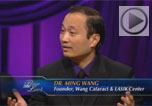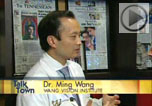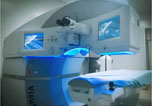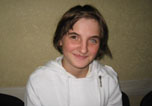- Over 55,000 LASIK and cataract procedures (including on over 4,000 doctors)
- The FIRST center in TN to offer Laser Cataract Surgery
- Introduced bladeless all-laser LASIK to the state
- Implanted the state's first FOREVER YOUNG™ Lens
- The first surgeons in the US to perform a new Intacs surgery to treat keratoconus
- Helped patients from 40 states and 55 countries
- International referral center for cataract surgery and LASIK complications
- Read Dr. Wang's book: LASIK Vision Correction
Why did you decide to have LASIK? Why did you choose Dr. Wang? How has your life changed since your LASIK procedure?
What is your advice for people considering LASIK?
Click to read more
LASIK Eye Surgery in Nashville, TN - FAQs
Wang Vision 3D Cataract and LASIK Center, Nashville, Tennessee
Click here to read Dr. Wang's textbook on LASIK
How Many LASIK Eye Surgery Procedures Has Dr. Wang Performed And What Is His Success Rate?
Dr. Wang has successfully performed over 55,000 LASIK procedures, including over 4,000 procedures on doctors. His success rate is 99.8%. Success is defined as the percentage of his patients who were able to legally drive without correction after the procedure.
What Is The Main Qualification That Differentiates Dr. Wang From All Other LASIK Surgeons?He is one of the few LASIK surgeons in the world today who holds a doctorate degree in laser physics. A Harvard and MIT graduate (magna cum laude), he strives to stay current with the highest technological advances and further develop his surgical skills.
What Is the Difference Between PRK and LASIK?Both are laser eye surgery procedures that use the excimer laser to reshape the cornea and correct nearsightedness, farsightedness, and astigmatism. With PRK, the laser is used on the surface of the eye, while in LASIK, the laser work is performed under a thin, protective, corneal flap. The long-term results are similar. Additionally, visual recovery with LASIK is usually faster, with less discomfort and less possibility of scarring.
Does LASIK Hurt?Before the LASIK procedure begins, your eye is numbed by anesthetic drops. While you may feel a pressure sensation as the corneal flap is being made, actual pain is rare. Any discomfort you may feel subsequent to the LASIK procedure will last only a few hours. Sleep and lubrication, as well as Tylenol or ibuprofen, are usually enough to counteract any discomfort.
Can You Guarantee 20/20 Vision?As with any surgical procedure, there are no guarantees. Although the results are extremely good (ninety-five percent of laser eye surgery patients in national studies no longer need glasses for driving), the results of the procedure depend on your initial refraction, your own healing characteristics, and other factors. It is good to look at LASIK vision correction surgery as a way of achieving an extreme decrease in your dependence on glasses or contact lenses. If 20/20 vision is not obtained after the primary LASIK procedure, enhancements may be effective to further improve vision. 20/20 can only be achieved in patients who have the potential to obtain 20/20 vision. For example, LASIK performed on a patient with a lazy eye that can only see 20/40 will only achieve 20/40 best-corrected vision.
Has Anyone Ever Gone Completely Blind from His or her LASIK Procedure?No. In millions of LASIK procedures done worldwide, no one has ever gone completely blind from a LASIK or PRK procedure, although you can lose a significant amount of vision if the procedure is not performed correctly.
Can Both Eyes Be Done at Once?LASIK is often done on both eyes at the same sitting. The results are so predictable and the procedure safe enough that most people undergoing LASIK surgery prefer to have both eyes done on the same day. The advantage of bilateral surgery is the convenience of having both eyes done at once. It also restores your balanced vision as quickly as possible.
One theoretical advantage of unilateral surgery is that if one eye should become infected, the second eye would have an increased risk for this complication as well. Infection turns out to be a very rare occurrence, so this advantage becomes more of a theoretical benefit. Another theoretical advantage quoted by proponents of unilateral surgery is that the results of the first eye can be used to fine-tune the results of the second. Again, in practice this turns out not to be clinically significant in most cases. At the time of your consultation, you will be advised of the advantages and disadvantages of both options. The final decision should be based on Dr. Wang's recommendations and your desires.
What Are the Results of LASIK Surgery?Results may vary from surgeon to surgeon and from center to center. Results also vary depending on your initial refractive error. With higher amounts of myopia, hyperopia, and astigmatism, results are less predictable and retreatments are more common. Dr. Wang is one of the most experienced LASIK surgeons in the country and uses the latest laser technology. His results have been exceptional.
How Long Will the Correction Last?Eyes typically stabilize around 3-6 months after surgery. Once that occurs, your correction is permanent. Any additional need for glasses after that will be the result of normal aging processes that befall everyone and not due to any instability in the refractive procedure.
What about Enhancement Surgery?In the event that you heal such that vision is less than expected after your initial LASIK treatment, it is possible to perform an additional treatment. But first your eye must stabilize and be healthy enough to undergo another surgery. Typically, retreatment with LASIK usually takes place no earlier than three months after the original procedure. With PRK, this can occur after about six months. In PRK, the front surface of the cornea is treated again, and the recovery time is a week to a month. With LASIK, the corneal flap usually does not need to be recreated. Using specialized instruments, Dr. Wang can just gently lift the preexisting flap and perform additional laser work. Recovery time is similar to the original procedure. Such enhancement surgery is usually not an additional charge but is considered part of the original fee if performed within a specified time after the original surgery.
I Have "Dry Eyes." Will This Affect My LASIK Surgery?Many patients seeking refractive surgery do so because they have dry eyes and are unable to wear contact lenses. It is important that your dry eyes be treated. This usually involves the use of tear supplements and punctum plugs (tiny silicone plugs placed in the tear drainage openings of your eyelid) that delay the drainage of your own tears so your eyes will stay moist.
After the procedure, your operated eye may feel temporarily drier because the corneal nerves are severed during LASIK surgery, causing the eye to make fewer tears. This condition is temporary and typically lasts three to six months. PRK may result in dry eyes post-operatively because the ocular surface is irregular, but this is also temporary.
Dry eye symptoms can be particularly noticeable if you use the computer frequently, read for long periods of time, or drive extended distances. These types of activities exacerbate dry eyes because they cause you to stare and not blink as often. It is important to use ample lubrication, especially during the first few months after surgery. We recommend using preservative free tears every 15 minutes for the first week, and every 30 minutes for the second week.
If I Need to, Can I Wear Contact Lenses after Surgery?If you have a residual refractive error and choose not to have an enhancement procedure, you may elect to wear contact lenses in four weeks. If you were a good contact lens wearer before LASIK, it is unlikely you will have problems afterward.
What Is Monovision?In patients who already experiencing difficulty with reading vision in their distance correction, it is possible to treat one eye for near vision and the other for distance vision. This decreases the necessity for both near and distance glasses. This method is used with LASIK, PRK, and CK.
If you are considering monovision, it is advisable to simulate the surgery with contact lenses before proceeding directly to LASIK surgery. If you have already been successful with monovision in contact lenses, you will most likely enjoy this type of correction following PRK or LASIK. If you are over forty and hope to avoid glasses altogether in your life, this is presently the only way to accomplish this.
Can There Be a Problem with My Eyes Twenty Years from Now Because I Had LASIK?This is very unlikely. LASIK is a form of lamellar refractive surgery, and lamellar refractive surgery (myopic keratomileusis) has been performed since 1949. Patients who have undergone these related but less accurate and more invasive procedures fifty years ago have not had any unusual problems.
Can I Have Cataract Surgery If I Need It in the Future?Yes. The surgical technique used will not change. However, your lens implant will be calculated using a different formula.
Will Having LASIK Prevent Me from Getting Other Eye Diseases?No. LASIK does not prevent cataracts, glaucoma, macular degeneration, or any other eye disease. Ophthalmologists term LASIK as disease neutral: It doesn't cause disease, it doesn't prevent disease, and it doesn't prevent diseases encountered in the future from being treated.
What Does Laser Vision Correction Surgery Cost?Please call us (615)321-8881 for detailed information on the surgical refractive correction (LASIK and PRK) fee. For more financing information, click here
Will Insurance Companies Pay for LASIK Surgery?Some insurance companies will pay for the procedure, but that is the exception rather than the rule. Check with your specific insurance carrier to see whether it covers LASIK, and/or whether there are discounts available through your plan.
Who Is a Candidate for LASIK Vision Correction?- You must be at least eighteen years old, with a stable glasses prescription.
- Good candidates have myopia up to -11.00 or hyperopia up to +6.00.
- Your level of astigmatism may be as high as 6.00 diopters.
- You cannot be pregnant or nursing, have any unstable medical condition, or any uncontrolled eye diseases.
- It is also important that you have reasonable expectations.
- Anyone whose prescription is actively changing more than one diopter per year.
- Anyone who feels that he or she must absolutely gain 20/20 vision without glasses or contact lenses. (No surgeon can guarantee 20/20 vision without correction. Think of it, instead, as achieving decreased dependency on glasses and contact lenses.)
- Anyone unwilling to accept the possible risks and complications of LASIK surgery.
- Anyone with an uncontrolled or untreated eye disease. Certain corneal dystrophies or a history of herpetic keratitis (a herpes infection in the eye) may be relative contraindications, as are certain arthritic syndromes.
With LASIK you can usually drive within one to three days. This depends on whether you have one eye done at a time or have simultaneous surgery on both eyes. The Department of Motor Vehicles typically grants unrestricted driving privileges to individuals who possess 20/40 or better vision. Over ninety percent of all patients who undergo LASIK surgery have this level of vision or better by the first day after their procedure.
When Can I Return to Work?With LASIK, the majority of patients can return to work the next day, although it is advisable to take twenty-four hours off following surgery on both eyes. If you work in a dusty environment, you should wait forty-eight hours prior to returning to work.
While most patients can function normally at work the day after their LASIK and CK procedures, we recommend that you not schedule any unbreakable appointments or meetings on that day. If your recovery is delayed slightly, you will still be able to accommodate the delay without any undue stress.
How Does the Excimer Laser Work?Many patients ask, "How can a laser correct my vision?" The laser removes tissue from the center of the cornea (in the case of myopia) to flatten its curvature and correct nearsightedness. In the case of farsightedness, tissue is removed from the periphery of the cornea to steepen its central curvature. The laser essentially reshapes the cornea's front surface. To do this, the corneal stroma (tissue beneath the corneal epithelium) must be exposed. This can be accomplished by creating a corneal flap. The LASIK process then uses the excimer laser to reshape the cornea under a thin, protective, corneal flap. Rather than vaporizing the epithelial cells to expose the corneal stroma, a flap of corneal tissue that is attached by a "hinge" is used in LASIK. At Wang Vision 3D Cataract and LASIK Center, Dr. Wang has rejected the use of the blade, and prefers to use a laser with the bladeless Intralase procedure.
This flap is gently pulled back like a tiny, clear, hinged lid and the corneal stroma is exposed. The laser part of the LASIK procedure takes place in the exposed corneal bed. The laser application itself lasts about thirty to ninety seconds.
After the exposed corneal stroma is treated by the laser and minute amounts of cells are vaporized, the flap is replaced in its original position. Amazingly, the flap is held in position by the eye's natural suction facility and provides increased comfort and decreased recovery time for the patient. The entire procedure takes approximately ten to fifteen minutes per eye and again is virtually pain free.
What is Custom-CAP Treatment For LASIK Complication?Custom-CAP is a FDA approved HDE technology that treats one of the most serious post-LASIK complications: decentered treatment, which result in poor vision. Up to now, it has been untreatable.
Is Wang Vision 3D Cataract and LASIK Center The Only Center In Tennessee That Offers The New Custom-CAP LASIK Technology?Yes. In fact, our center is one of the busiest LASIK complication referral clinics in US today. We see LASIK patients with complications almost daily who come from around the country.
How Does the Custom-CAP Treatment Work?Dr. Wang is currently the only surgeon in Tennessee that performs the new FDA HDE approved Custom-CAP treatment for one of the most serious complication after LASIK: decentered treatment. This results in poor vision and has previously been untreatable. He uses corneal mapping technology to custom shape the cornea, program the laser, and recenter the previously decentered treatment.
What Is The Implantable Contact Lens (ICL)?Dr. Wang was the first surgeon in Tennessee to perform the implantable contact lens (ICL) surgery. ICL is a new technique that inserts an implant inside the eye, in front of the natural crystalline lens, to treat high ranges of refractive error. Pateints whose refractive errors are outside the range of LASIK are candidates for this procedure.
How Does Implantable Contact Lens work and what is a Bioptic procedure?In this surgery, an implant is inserted into the eye and placed in front of the natural crystalline lens, to correct high degrees of refractive error. It is coupled with a Bladeless Intralase LASIK (hence the term "BIOPTIC" -- two procedures) when required to fine tune the vision. The lens is left in place for years, until your develop cataracts. Then both the implant and your natuaral lens are removed.
What is PRK?Photorefractive Keratectomy (PRK), also called "surface ablation" This is a procedure in which the front surface of the cornea is directly sculpted by the excimer laser. The surgeon prepares the eye by gently removing the surface layer known as the corneal epithelium. This layer regenerates itself within a few days. Computer-controlled pulses are directed at the exposed surface (corneal stroma) to reshape the cornea. Less than ten percent of the cornea is affected, with the deeper layers remaining untouched. The entire procedure takes approximately ten minutes per eye. PRK is an option for those patients with thin corneas who cannot undergo LASIK.
A brief comparison of PRK and LASIK is outlined in the following chart.
| PRK | LASIK | |
| Range of correction | Low to moderate | Low to severe |
| Depth of penetration | Superficial | 20% deep |
| Intraoperative pain | Minimal | Minimal |
| Postoperative pain | Moderate, 24-48 hours | Minimal, 12 hours |
| Postoperative medications | 1 month, possibly longer | 1-2 weeks |
| Functional vision recovery | 3-5 days | 24 hours |
| Visual results fully recognized | 3 weeks to several months | 1-4 weeks |
| Return to work | 3-7 days | 1 day |
| Risk of complications | Low (less surgeon dependent) | Low (more surgeon dependent) |
| Risk of haze (scarring) in the central cornea | 1-2% | <1% |
If you're interested in surgical correction, choose experience and technology. Choose Wang Vision 3D Cataract and LASIK Center of Nashville, Tennessee. Call or email us today.
Our new texbooks
A 501c(3) charity that has helped patients from over 40 states in the US and 55 countries, with all sight restoration surgeries performed free-of-charge.




















